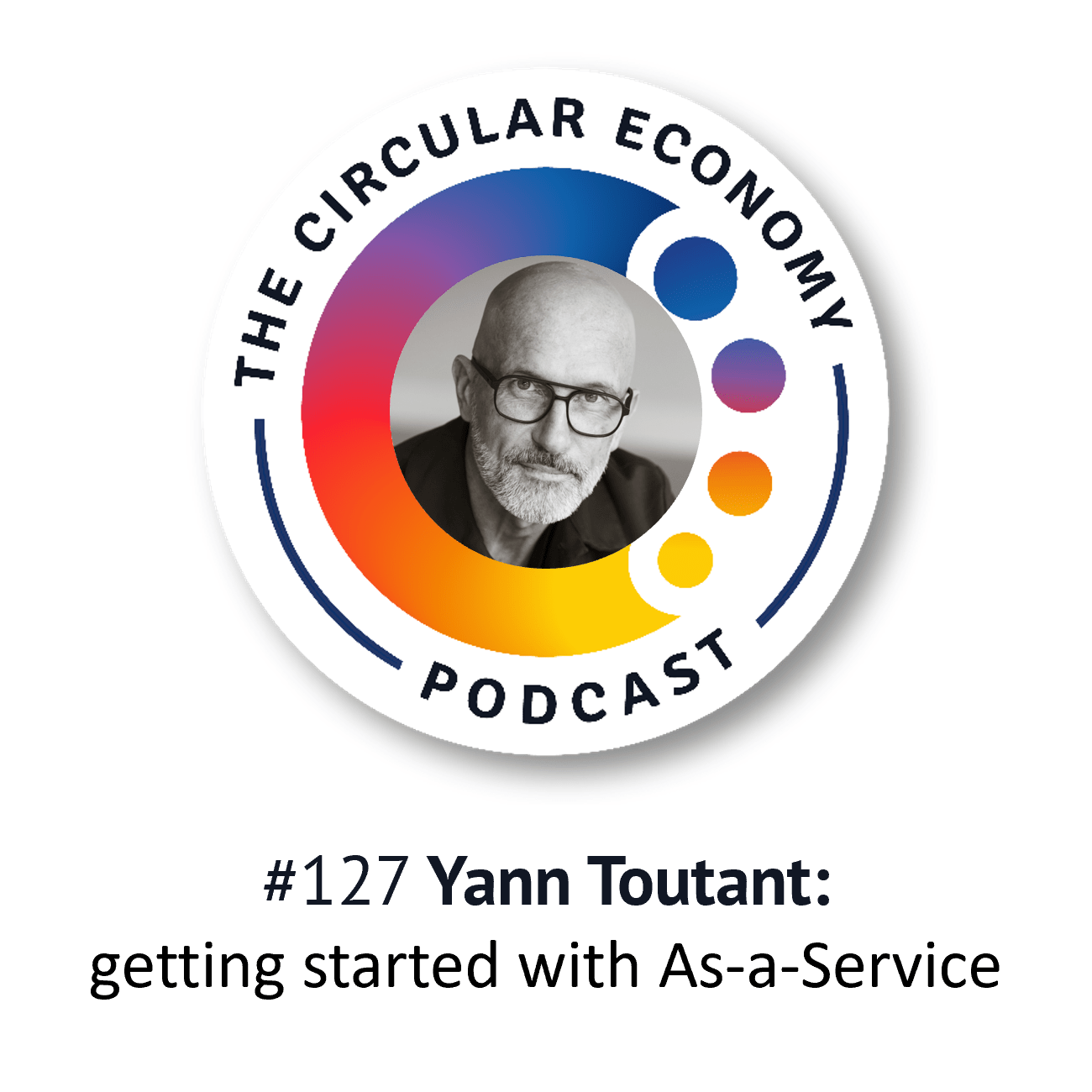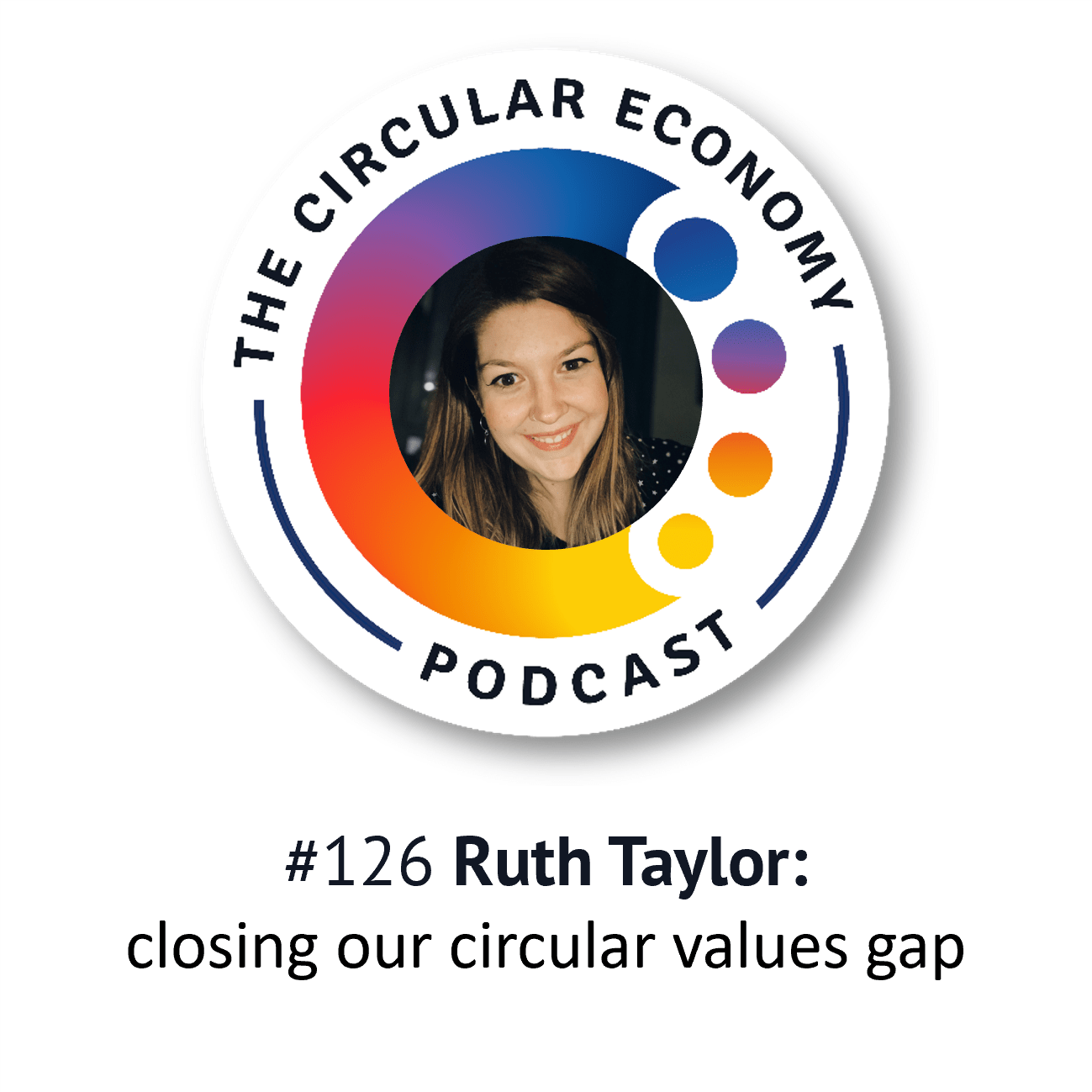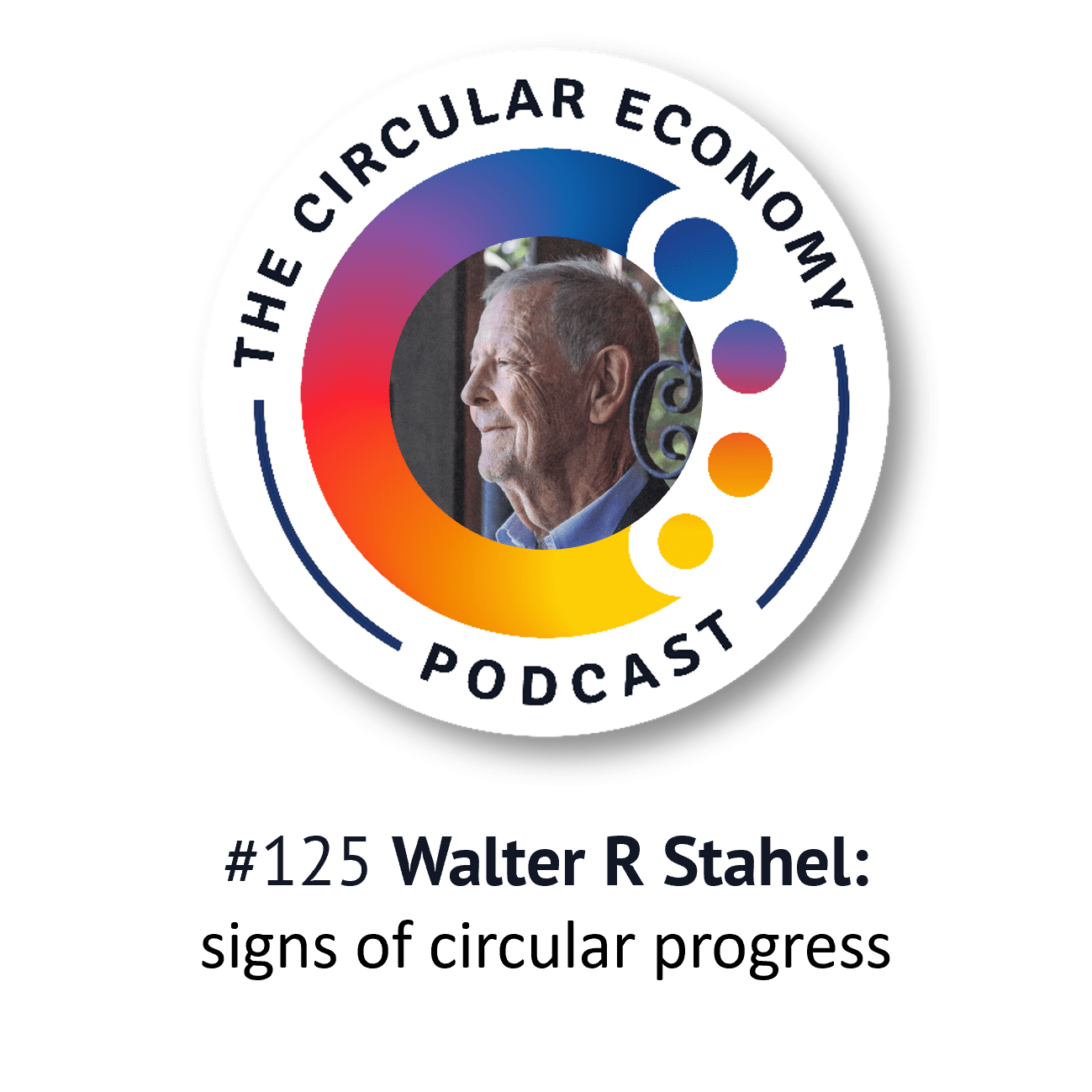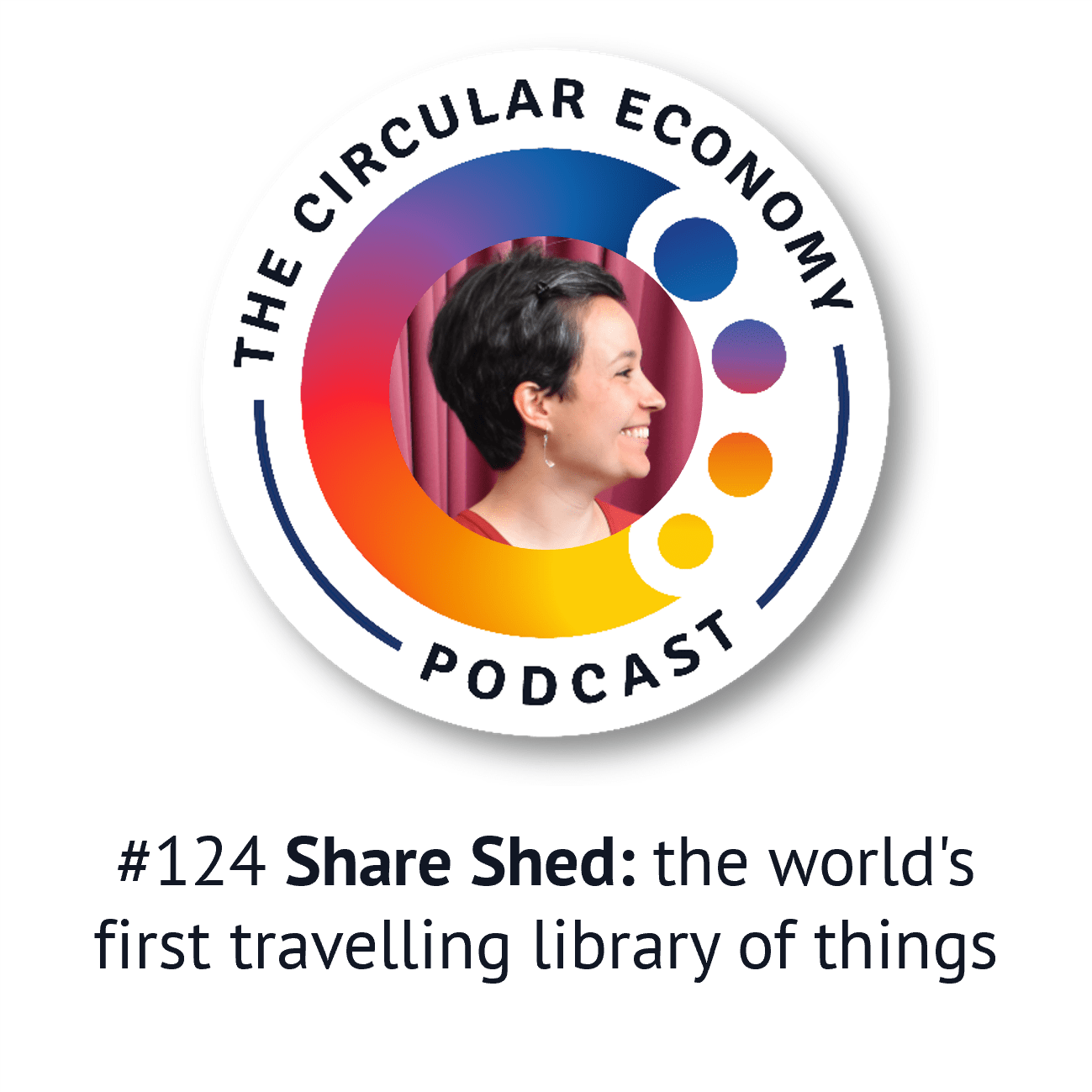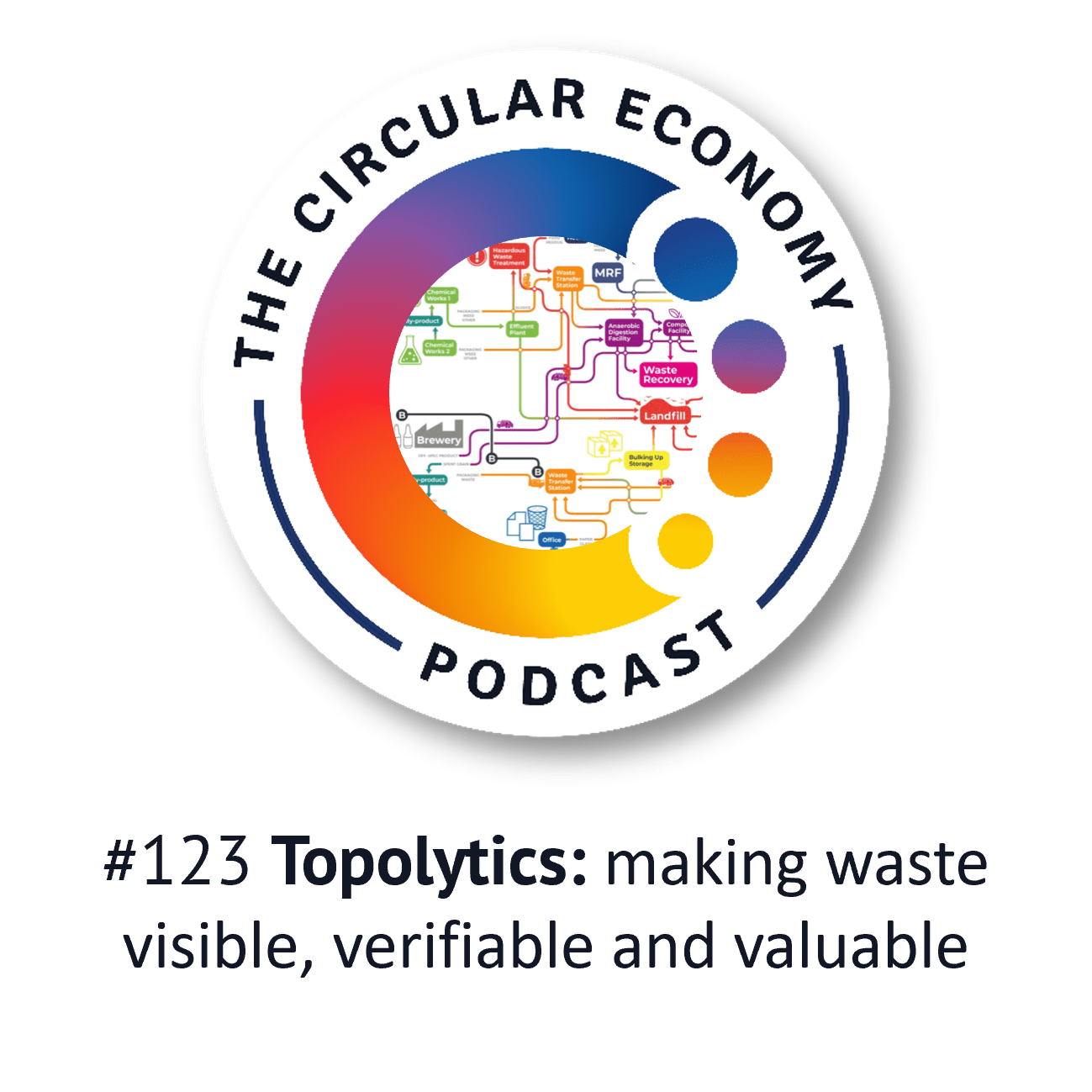Podcast: Play in new window | Download
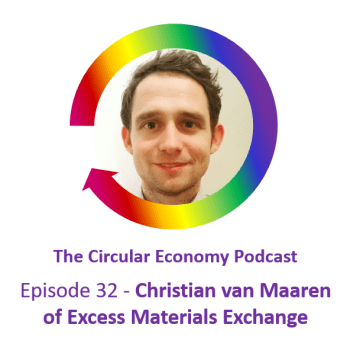 In this episode, Catherine Weetman talks to Christian van Maaren, co-founder of Excess Materials Exchange, based in the Netherlands. Excess Materials Exchange is saving the planet by running a dating site, which at first sounds improbable, and then sounds intriguing!
In this episode, Catherine Weetman talks to Christian van Maaren, co-founder of Excess Materials Exchange, based in the Netherlands. Excess Materials Exchange is saving the planet by running a dating site, which at first sounds improbable, and then sounds intriguing!
Christian describes himself as a chronic optimist, always looking at possibilities to achieve the seemingly unattainable. He is driven by making the world inclusive and circular and is convinced that the Circular Economy plays a paramount role in the energy-climate challenge whilst delivering sound business results.
We talk about Christian’s background working for Shell, and how he’s switched from corporate life to being an entrepreneur.
Christian believes the circular economy is one of the fastest and cheapest ways to achieve the Paris climate goals, and we hear how Excess Materials Exchange helps customers measure the value of their exchange options, in financial, environmental and social impacts.
Their analysis shows exchange is better for your profits as well as our planet, with material flows typically increasing by 110 per cent in financial value, and ecological footprints reducing by an average of 60 per cent.
Christian tells us about the kinds of companies and materials they match up, using a combination of blockchain and AI, and how they actively match supply & demand for materials to ensure high value re-use.
Podcast host Catherine Weetman is a circular economy business advisor, workshop facilitator, speaker and writer. Her award-winning book, includes lots of practical examples and tips on getting started. Catherine founded Rethink Global in 2013, to help businesses use circular, sustainable approaches to build a better business (and a better world).
Stay in touch for free insights and updates…
Read on for a summary of the podcast and links to the people, organisations and other resources we mention.
You can subscribe to the podcast series on iTunes, Google Podcasts, PlayerFM, Spotify, TuneIn, or search for “circular economy” in your favourite podcast app. Stay in touch to get free insights and updates, direct to your inbox…
Links we mention in the episode:
- Excess Materials Exchange website: excessmaterialsexchange.com
- On LinkedIn https://www.linkedin.com/company/excess-materials-exchange/
- Christian van Maaren on Linkedin: https://www.linkedin.com/in/cvanmaaren/
- Excess Materials Exchange Co-Founder, Maayke Aimee Damen’s TEDx talk from 2020 https://youtu.be/7A8x_cIjG1o
- PRé consultants – https://www.pre-sustainability.com/
- Copper8 (circular procurement) https://www.copper8.com/
Other podcast episodes about materials exchange:
- Episode 8 Elaine Kerr – industrial symbiosis https://www.rethinkglobal.info/elaine-kerr-how-industrial-symbiosis-oils-the-wheels-of-the-circular-economy/
- Episode 26 – Katie Briggs of the Textile Review https://www.rethinkglobal.info/episode-26-katie-briggs-of-the-textile-review/
- Episode 31 – Tom Fecarotta of Rheaply https://www.rethinkglobal.info/episode-31-tom-fecarotta-of-rheaply/
Christian van Maaren
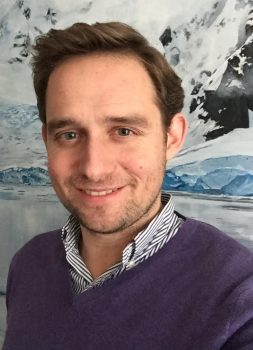 Christian, as a chronic optimist, always finds possibilities to achieve the seemingly unattainable. With his sense of humor and ability to see the bigger picture he is able to successfully align unconventional stakeholders over complex challenges, as he did many years for Shell. His vision, curiosity and wit make him a skillful entrepreneur. Driven by making the world inclusive and circular he brought light in remote places with Global Himalayan Expedition and now the Excess Materials Exchange is his new venture. He is convinced that the Circular Economy plays a paramount role in the energy-climate challenge whilst delivering sound business results.
Christian, as a chronic optimist, always finds possibilities to achieve the seemingly unattainable. With his sense of humor and ability to see the bigger picture he is able to successfully align unconventional stakeholders over complex challenges, as he did many years for Shell. His vision, curiosity and wit make him a skillful entrepreneur. Driven by making the world inclusive and circular he brought light in remote places with Global Himalayan Expedition and now the Excess Materials Exchange is his new venture. He is convinced that the Circular Economy plays a paramount role in the energy-climate challenge whilst delivering sound business results.
“Before Excess Materials Exchange I worked for Shell. That was a completely different world. However, during my early years for Shell, I got the opportunity to go on an expedition to Antarctica with Sir Robert Swan, and a group of highly motivated change makers from all over the world.
This experience turned out to be life-changing. It made me decide to focus my work on sustainability. I first did this inside Shell, by managing their green infrastructure and natural capital program for North- & South America. On that program, I was working together with a lot of NGO’s and also got acquainted with the circular economy topic.
I realised that the circular economy was one of the quickest and cheapest ways to reach the Paris Agreement climate targets. So when Shell decided to cut back on the program I worked on, I decided to leave the company and be more directly involved with sustainability. This is when I met Maayke Damen (my co-founder) through an organisation called the Young Club of Rome. The rest is – as they say – history.”
Excess Materials Exchange is a dating site for secondary materials and waste. We use a combination of blockchain and AI to actively match supply & demand, and materials with technologies that can ensure high value re-use.
Transcript
Please add 3 mins 30 sec to the timings to allow for the music and intro.
Catherine Weetman 01:19
Today we’re talking to Christine van Maren, co-founder of Excess Materials Exchange based in the Netherlands. Excess Materials Exchange is saving the planet by running a dating site, which at first sounds improbable, and then sounds intriguing. Christine describes himself as a chronic optimist, always looking at possibilities to achieve the seemingly unattainable. He’s driven by making the world inclusive and circular. And he’s convinced that the circular economy plays a paramount role in the energy-climate challenge. Whilst delivering sound business results. Christian Welcome to the circular economy podcast
Christian van Maaren 02:00
Thank you very much, Catherine. Thanks for that introduction.
Catherine Weetman 02:04
I notice your career includes working for Shell, the global energy company. So before we get into the how, and find out about Excess Materials Exchange, I’m curious about the why. What’s at the at the root of your drive to make the world more circular?
Christian van Maaren 02:21
That’s a very good question. And maybe also a bit odd that I used to work for Shell and now have a company in the circular economy domain. But the story is actually a bit stranger. Because I used I started off studying aerospace engineering, but found that I’m not the best of engineers. I also noticed that maybe my own personal How would you say that effect in the aerospace industry was going to be quite limited and I want to make I guess, I was always intrinsically motivated to make an impact, positive impact. And I realised while I was studying that perhaps the energy industry is one of the winners She’s going to have the biggest impact on our future. I thought back then, maybe 100 years, but as it turns out, it could be much longer, much, much more significant. So I started working for Shell with the naive ambition as you are young professionals to see if I could change the company from the inside out. I think I’ve worked for them for about six years. And I have to say I’m quite satisfied with what I was able to do. I became the chairman of the young professional organisation, so I was able to influence some of the young future leaders of shell hopefully, they haven’t forgotten about as they are moving on in their career. And in the last role that I had, I was managing the national capital and green infrastructure programme for North and South America based in Houston. And I was doing projects where we were building oyster reefs, mangrove forests and wetlands, which was a really cool role. Still, maybe A bit weird why shell was doing that then they were doing that really not just to make things right, but really to see if they could do business in a very different way really sort of working with nature as opposed to protecting themselves from nature. And it was also through that work, as I was working with a lot of NGOs in the US, that I got acquainted with the circular economy, and realised that the circular economy may be one of the fastest and cheapest ways to reach the Paris Climate Agreement targets. So when I think it was in 2015, and 20, or 2016, when the old price took a nosedive, shell decided to cut back on the programme, which I also thought was a nice moment to leave the company. Leave also a bit of the company politics because I thought they were a bit frustrating at the time and be more directly involved in in stainability. It was also at that time I met Mike, my co founder through an organisation called the Young Club of Rome. I moved back to Europe and that’s when we started the Excess Materials Exchange.
Catherine Weetman 05:13
Great stuff so yeah, that’s some inspiring that even before joining shell, you know, you wanted to try and change the world. And I think, having had a corporate career, myself working for big companies like Tesco, Kellogg, DHL. You can see an awful lot of possibilities from being able to make sustainable changes, but trying to get momentum behind things and trying to get other people to move away from business as usual, is more difficult than it might first appear. So let’s move on to the how of the Excess Materials Exchange. How does it work? From the customer’s point of view? Tell us a bit about the, you know, the business model, and then what it looks like when a client gets engaged.
Christian van Maaren 06:11
Sure. So the way that we work is is basically threefold. What we do is that when a company comes to us with a particular material flow or with a product, we give an identity to that stream or to that object, because we see that waste is really a material without an identity. And by giving it back that identity using something that we call the resources passport, it then gets almost by having that I didn’t see value again. And next to the identity, we add intelligence to that. And we do that through a host of artificial intelligence tools that we’re building. And we’re combining that with our own intelligence which is not so artificial. And that’s the the engine behind our matchmaking process, and next to the intelligence, we use an integrated approach. We help our clients really from the start till the end with the matchmaking as much as we can, but as also as much as the client needs. If it’s like a large company that we work with, they probably want to use their own logistical service provider or their own legal advices. But if they don’t have that, because they’re, you know, maybe a bit of a smaller organisation, we can help with that as well. Because in our network, we have specialised, you know, legal advisors or just service providers that can help them, you know, with with the whole transaction, and next to death. And also I would say part of that integral approach is that we express the value of the products and the industries that we process in a financial way. We have tools that help us to quantify the financial value of these But these particular streams, but we also give it an environmental value. Together with Ernst and Young we’ve developed this methodology are really really slightly tweaked the methodology that they have, that expresses the environmental impact that you can save with the matches on our platform using eco cost for you basically express the sort of the cleanup costs, that you save generations from having to clean up the sort of the mess that we normally create today in eco costs. And that we find really helps convince the the people that we work with in organisations, which is often the innovation department or the sustainability department to convince internal stakeholders that are normally more used to speaking in terms of money like the CFO or operational managers. And we find that that whole integral approach of giving waste identity by using AI in the matchmaking process which really reduces At the cost of transaction, and combining that with that integral approach helps make it easier for the clients to match these these flows.
Catherine Weetman 09:11
Hmm,sounds interesting. So in terms of the values, are you looking just at the potential resale value for it going into different streams? You know, I was looking at the example from on your website of the the rail track, and that that could go, say, into fencing or maybe into construction beams, which would really increase the value. So is it just the value of the what the resale value of the waste? Or are you helping them look at the cost of disposing of the waste now? You know, the negative value they avoid?
Christian van Maaren 09:50
Well, actually, it’s a good question. We look at both on one and we compare the current end of life situation, you know, which in the case of railroad tracks is, is not that negative Because it’s sold for scrap value. Oh, in this case and I love this is one of my favourite cases to be honest, we found that the value as a construction beam is far higher. But that’s just the financial value. But we also calculate is the environmental cost currently of the end of life situation which in this case is mostly shipping it to either turkey or China and having it melted down again because it’s just sold on the international scrap market. Versus avoiding the the having to build new construction beams for the construction industry. So with that, you don’t only have like a higher gain for your products but you also have a big difference in the impact of your cost. And that’s combined to that added up to each other is the total value of then the the product which is the financial value, plus the environmental impact. If you save
Catherine Weetman 11:00
Yeah, that’s a really good point. So thinking about all the different options for the next use of that material, and how much intervention is going to be required to get it back into the system. That’s often one of the criticisms about plastic recycling, isn’t it that there’s so much energy goes into the separation of the different plastics, and then the recovery back into something usable, that it can almost be as bad as, you know, using the petrochemical in the first place.
Christian van Maaren 11:33
idea, and the most thing there is that you we don’t currently know, right? So it’s important to to quantify what that information is what that data is, and then let it help you in the decision-making process because maybe in some cases, it does make sense to recycle it. But in some cases, maybe it doesn’t. And one of the things that we always wanted when we started this project is that we want to have archives Lions give them the ability to base their decisions on financial metrics. So really the financial value of the matches that we identified for them environmental, but also social. And the social piece is something that we started a pilot of this year with a company called prey consultants. And that’s been a very interesting journey as well, where we found that expressing or measuring social impact is actually quite difficult. It’s also quite new. And there’s not a lot of established databases on that yet in the world. There are some and we use that for this pilot that we’re working together with today. But also, we find really important to help companies in decision-making process because sometimes something may have a very good financial business case and a good environmental business case. But the maybe just social aspects of it can be quite negative, huh.
Catherine Weetman 12:57
Yeah, that’s interesting and was doing a webinar yesterday and there was a question about the circular economy for developing countries. And that can be one of the issues there that, you know, if we’re sending recyclate, abroad to be processed, we may not know whether it’s being processed legally safely. You know, is it exposing people to toxic chemicals or that kind of stuff? So I guess it’s the same with that with the front end of the supply chain. If you don’t know enough about who’s involved and whether they’re paying a fair wage, providing safe working conditions, all that kind of thing, then you’re not really being a responsible company.
Christian van Maaren 13:40
Absolutely. And you know, you said it, well, it all starts with measuring it, and quantifying but also presenting information in a way that is useful for decision-makers. And the social piece there is quite challenging. Do you think about it, for example, co2 emissions, if you have 50 tonnes of co2, everybody would agree with you that it’s better than 100 tonnes. But when it comes to social indicators, it’s much more challenging. People always, you know, everybody would agree that having work versus no work is better. But working 16 hours a day is not great either. So it’s much more difficult to express that in a meaningful way. And we’re now we just finished off a pilot with pay consultants on the railroad tracks and on orange juice, hope you were able to present something about that soon. I would also love actually for people to give feedback on that this is nothing just a tool that we use to make to help in the decision making process but not something that we want to own per se. We just want to make matters that makes sense.
Catherine Weetman 14:48
Yeah, and I guess it’s similar to the way that the city of Amsterdam say they’re going to be using the donut in their decision-making process Kate Raworth’s Doughnut Economics model It’s not, it’s not going to necessarily be a way to lead them directly to a decision. But it’s going to give them a checklist of all the things that they need to consider and try and weigh up. And sometimes, you know, if there’s no perfect solution that meets the criteria of the inner foundation of the Doughnut, the social foundation and stays within all the all the planetary boundaries, then you have to make choices, don’t you about whether option A is is better than option B. And it may not may not be clear cut some you know, because because there aren’t any, or aren’t enough perfect solutions out there. You have to just make a compromise now and hope that you’re able to improve that choice later.
Christian van Maaren 15:49
Absolutely, it’s always trade off. And I think the trade off can only be made once the data has been measured and presented.
Catherine Weetman 15:58
Yeah. And again, thinking about the evolution of some of the examples in the circular economy. We were talking before the podcast about the coffee supply chain. And I noticed in the in the video on your website, there were a couple of examples aside, not not come across and so I added them to the 15 or so that I’ve already got. But things are evolving all the time, aren’t they with new new innovations for turning waste, apparently waste materials into a new resource or extracting value from biomaterials with through by refining and green chemistry and all that sort of stuff. So is one of the things that you can offer to your customers, as sort of, you know, a regular revisit to see if there’s now a better a better value option for their waste because of innovation, or now there’s a more local need for that particular material.
Christian van Maaren 16:56
Yeah, absolutely. Basically, if you if you flatten what we do As the number of things we create the economies of supply and economies of demand, because we map resource flows, and we always look out for companies that could use certain excess materials or waste. And also because of that, by making those streams visible, all of a sudden that may become interesting for another company to invest a little bit more money on getting a certain processing capability on the market so they can tap into the value that that data provides. And also what we do is that we build a fairly big database now about 4000 entries in which we have mapped all the different recycling or reuse abuse that there are around the globe, mostly focused on Europe. And we’ve also added to that database the technological readiness level. But this can also inform our clients on you know what is already currently operational that they can just more or less plug and play But also on things that are on the horizon and things that they may be able to plan for or maybe even invest in, because they just want to give it a little nudge to get ready for the market.
Catherine Weetman 18:11
Hmm, yeah, that’s a good point. And yeah, in in my own, sort of, call it a database, but it’s a spreadsheet really of 600 odd, circular economy examples. That’s one of the things I’ve done if if somebody just had a research breakthrough, but it’s not yet commercialised, then I’ll you know, I’ll note that it’s at that stage rather than being a fully-fledged up and running thing. And a lot of those, if you go back a couple of years later, have made it to market but some of them may not have done. So yeah, I think things are just changing so quickly that, you know, it’s got to be one of the underlying principles, hasn’t that for anybody involved in the circular economy is to keep looking at what’s what’s evolving outside to see if there’s now a better solution than the one that started off with.
Christian van Maaren 19:02
Absolutely. And the way that we approach that is by building what they call a semantic web of the circular economy or a linked database where we link the information from the passports that are in our database, looking at information by a product level on a component level, and on a material level, but also on a functional level. And then linking that to other database that we have on recycling, capacity recycling capability, other reuse options that are are for all sorts of materials. And by connecting those and then laying those all on top of each other, you create what they call this semantic web. And that would help us to not only find matches much quicker, but also find much more relevant than maybe interesting matches. But of course, as this database grows, and as we connect it with information on environmental impact, and on social impact, it allows us to keep us Sort of evergreen and keep our clients informed of what is going on and what the impact of their decisions is. But that’s just our hypothesis or maybe our hope, our dream that it will, you know, help our clients to stay abreast of what’s going on. But also turn secondary materials or waste, we try to avoid the word waste in to almost a commodity, right? Where, where it’s this way companies have going into very long term contracts with some of the value chain partners that they may have. Seemed like well, maybe let’s have a contract for one or three years because we feel like maybe in three to four years, the new technology will be spoken online, it will be able to give this particular material much more value. web. And that would help us to not only find matches much quicker, but also find much more relevant than maybe interesting matches. But of course, as this database grows, and as we connect it with information on environmental impact, and on social impact, it allows us to keep us Sort of evergreen and keep our clients informed of what is going on and what the impact of their decisions is. But that’s just our hypothesis or maybe our hope, our dream that it will, you know, help our clients to stay abreast of what’s going on. But also turn secondary materials or waste, we try to avoid the word waste in to almost a commodity, right? Where, where it’s this way companies have going into very long term contracts with some of the value chain partners that they may have. Seemed like well, maybe let’s have a contract for one or three years because we feel like maybe in three to four years, the new technology will be spoken online, it will be able to give this particular material much more value.
Catherine Weetman 20:44
Yeah, that’s a good point. And it reminds me of somebody I knew who was working on circular economy solutions in in London as a, you know, city council level and they found He found a company that could recycle mattresses really effectively. And mattresses, as I’m sure you know, the kind of, you know, major, major problem. But in talking to all the different borough councils in London, they found that a lot of them had signed up 15 and 20 year contracts with, you know, mattress disposal experts that were just putting them into landfill. So they’ve got a better solution, but couldn’t make progress with it because everybody was tied into existing contracts that were just sending it to landfill or, you know, incinerating it.
Christian van Maaren 21:37
So there we should avoid. Sorry, there’s not a lot. We should avoid this locked in risk at all times. I mean, you mentioned the example of the mattresses, I would say here in the Netherlands. There has been this surge of waste to energy plants where maybe, you know, 10 to 15 years ago, it seemed like a great idea to incinerate waste and turn it into you know usable heat for cities and industries. But now, as we find that there are much more useful outlets for these waste streams, cities are having to finance these huge plants, huge Capex-heavy plants, where they’re – basically we will call them these days material incinerators – places where materials come to die almost. But they have to be fed. So now they’re importing waste streams from the UK, from Italy, from all over Europe to keep these fires burning, I find it insanity.
Catherine Weetman 22:38
Yeah, it’s shocking, isn’t it? And it reminds me of some phrase, another podcast guest. Tom Ogonek, from Close the Loop – his phrase was “when it’s burnt, it’s gone”. So, like that’s it, you’ve lost the material completely. And thinking about your colleague Maayke’s Ted talk when she, you know, talks about waste being gold, you know, burning it and losing all that gold really makes you think that this is a really stupid idea to just burn waste. So yeah. And so in terms of the time that you’ve spent setting up Excess Materials Exchange and getting all this, this clever technology up and running, what surprised you in the process of doing all of that?
Christian van Maaren 23:33
Well, what I really liked about this process I really like about the process, I have to say is that the circle economy topic has created such a wonderful community of people that really want to make a difference. And I think you know, when you’re caught up in your day to day business and get frustrated by all the barriers, that’s something to easily forget, but on the other hand, also something that really energises us in the process. There’s so many ones For people doing so many great innovative things to really help advance this agenda. And that’s something that even as I’m telling this to you now gives me goosebumps not lying.
Catherine Weetman 24:12
Yeah, I think it’s it. It is really energising to find, you know, more and more people getting on board, with the circular economy and with sustainability, and finding that, you know, where we can make a difference in lots of different ways. And it’s just a lot of it is just a new way of looking at things. And you know, seeing the value in waste instead of just thinking. It’s something we have to deal with, and it costs us money, but it’s unavoidable. Now, companies are realising that there’s a different way of doing things. And I think, for me, there’s this kind of, you know, looking at your business differently, and then from the citizens’ point of view, looking differently at how we’re marketed to You know, I see a lot of things about consumer demand. And you know what, what consumers insist on. But people forget that that’s all come from somebody persuading us that that was possible in the first place. And that it, you know, it’s desirable. And it’s the best way to, you know, make yourself look good with your friends is to do X or by y. And so, you know, unpicking the business model from a systems point of view, thinking about where the value is going, what’s he spending money on? And how could you change some of those value flows? And then also, from the point of view of living in society, thinking about what we need to own what we just need to have access to, you know, do we really need to is this is buying all this stuff really making us feel better? Or is it just somebody telling us that that that’s what it’s going to do and and really, it doesn’t, so yeah, some really interesting things. changes. And I think, you know, the pandemic, the so many people saying things must change. Inevitably things must change. But also there’ll be a desire for people to, for people to do things differently because they’ve had time to step back and question. You know, why were we buying all this stuff that we didn’t need? Why, as we were talking before the podcast, why are we going into work every day when we could save ourselves a commute time and go for a walk? So yeah. So in terms of helping other people who might be inspired by going circular and wanting to make a difference? What would be your lessons learned and top tip?
Christian van Maaren 26:46
I mean, I love that question. And a while ago, there were a bunch of students from a French University visiting us here in Amsterdam, and they asked us the very, very question as I think about it for a little I told him, I said, Just maybe a bit like I said, if I, if I knew back then what I know now and all the barriers that we had to overcome and sort of the valley that we had to go through? I’m not sure if I would, I would do it. And you have to imagine I came from a pretty comfortable corporate life and then, you know, go straight into the deep end. I would say, My tip is just do it. Take the Step. Take dive, in the end is much more fulfilling, but you’re going to face a lot of challenges. Like I think, we thought that business will pick up much faster than it did. And my buffer sort of ran out. So we had a period of time where my diet was basically reduced to eating peanut butter sandwiches three times a day, for a couple of weeks, weeks. That was quite a sobering experience that I don’t necessarily would like to repeat. But I think at the same time, though, it’s this whole process and this whole journey has given me much more fulfilment. So, definitely love that I did it. No regrets. But
Catherine Weetman 28:09
yeah, that’s, that’s a really you know, insightful thing to share because I think often entrepreneurs and startups you know, it’s it can be tough and people can have to change direction partway through or find that it’s too early for their idea in the world. It doesn’t doesn’t make it not a good idea. But there’s not enough enthusiasm for it or, you know, there’s some, some technological or even just a funding barrier in the way. And, you know, just keeping plugging away and trying to find a different way around that problem, I guess is what makes the difference between those who were, you know, driven to to start something And, you know, those many of us who who, you know can kind of see good ideas but perhaps haven’t got the the drive and the tenacity to just keep sticking, sticking at it even though you’ve got to survive on peanut butter sandwiches for for two weeks, you know hopefully not much longer because I guess I guess it wouldn’t be all that good for you and your overall well being. So in terms of plans for the next phase of the business, how are you? You know, a still connecting with new customers, despite the pandemic is a more interest because people having to take a step back from the day to day
Christian van Maaren 29:52
or when the covid 19 pandemic hit, I was I was very worried to be honest and also a bit harsh Because I thought, Man, this, I thought this was really going to be our year. But then, and we have found that our revenues have decreased. So we do see that a lot of innovation and sanity. findability budgets have been frozen. But at the same time, we’re still very busy. So I’m very hopeful that we will weather this storm. And like you said earlier, there’s a lot of voices now and a big undercurrent of people saying, you know, we want to do things different as soon as this crisis is over. And perhaps that’s the break that we’ve been waiting for. Because I feel like our tools and the knowledge that we build up and experience that we have now can really help in manifest that desire, because honestly, it’s very in line with the desire that we had when we started this company. So of course, it’s horrible is happening right now. And it is a challenge, but at the same time, I feel like you know, this maybe is a sign for for the world to do things differently, I think here in Europe. We’re very well positioned to make that happen. There’s a lot of support from from the European, European Union, but also on different national levels. There’s a lot of a lot of question ambitions in this space. I think, you know, I started off with saying that I felt like that the circular economy is one of the the fastest and cheapest ways to reach the Paris Agreement targets. And we find that a lot of our work actually supports that and a lot of research coming out from a lot of other universities and Institute’s also supports that. So maybe this is that that event that sparked that will force the policymakers and maybe the big corporates and companies as well to look at the circular economy and see it as a way to reduce their impact not just on climate, but also on a lot of other factors, while not even having to lose any money, perhaps even make more money because they radically change their business model.
Catherine Weetman 31:58
Yeah, exactly. I think there are just so many ways that value leaks out of a business all the way along the supply chain. And so many innovations and research projects, you know, now finding ways to repurpose all that waste and either recirculate it back in into the same thing for the company, or find an industrial partner who can use that and you know, those, those people who’ve wanted to do something more sustainable, but have been held back because they couldn’t justify extra costs, and now finding ways to take those, those good ideas back to the company, and it’s a much easier way to make a business case. So I think, you know, people people are much more switched on to the fact that you can do something that’s both sustainable and profitable for the company. So yeah, hope hopefully, the momentum accelerates. So Is there anybody you’d recommend as a future guest for the programme to help inspire people about the circular economy?
Christian van Maaren 33:07
Absolutely. One of the persons that I would recommend for this podcast is Cécile van Oppen from Copper8. They’ve been a great partner for us as well in launching and developing our platform. And they’re focused on circular procurements and obviously procurements also a very important aspect of the transition towards a circular economy because a lot of nations worldwide, especially in Europe, the economies for a large part controlled by government spending so by helping decision-makers spending their money in such a way that they are stimulating and advancing this agenda, I think is a very important factor and important enabler in this transition. So I would love it if she would come on on this podcast, but definitely listen to that.
Catherine Weetman 33:56
Yeah, that would be great. And I think in every company There’s an opportunity to do circular procurement. Even if your company is not interested in, put in the circular economy at the heart of its strategy, you can just do things, you know so much more effectively. If you’re asking your suppliers to provide services instead of taking ownership of products and, you know, all those other good things. So that’ll be great. I’ll follow up on that. And Christian, how can people find out more about you? And about Excess Materials Exchange?
Christian van Maaren 34:31
Well, they can get it onto our website, Excess Materials Exchange.com or email us at info Excess Materials Exchange.com it’ll be the easiest way to reach us. Definitely. We’ll get your reply very quickly.
Catherine Weetman 34:47
Thank you and I’ll put those links in the show notes. Though it follows the golden rules of website naming doesn’t it? You know, kind of stick with the easy to spell and easy to remember. In, you know, it matches the company name. so fantastic. Thank you very much for taking us through the story so far of Excess Materials Exchange, I think with the EU circular economy policy, and the increase in you know, it’s a hashtag at the moment will build back better. I think lots of companies will be looking at how they can be more resilient as a business and how they can rethink cost that they’ve accepted, you know, the cost of disposing of waste costs they’ve accepted over the last so many years, and looking at how they can turn that into value. So I see a bright future for Excess Materials Exchange, and you and, and all the other companies in that space. Thank you very much for taking the time to talk through it.
Christian van Maaren 35:54
Thank you very much, Catherine was absolutely My pleasure.
Want to find out more about the circular economy?
If you’d like to learn more about the circular economy and how it could help your business, why not listen to Episode 1, or read our guide: What is the Circular Economy?
To go deeper, you could buy Catherine’s book, A Circular Economy Handbook for Business and Supply Chains This comprehensive guide uses a bottom-up, practical approach. It includes lots of real examples from around the world, to help you really ‘get’ the circular economy. Even better, you’ll be inspired with ideas to make your own business more competitive, resilient and sustainable.
Please let us know what you think of the podcast – and we’d love it if you could leave us a review on iTunes, or wherever you find your podcasts. Or send us a Tweet: @Rethink _Global.
Podcast music
Thanks to Belinda O’Hooley and Heidi Tidow, otherwise known as the brilliant, inventive and generous folk duo, O’Hooley & Tidow for allowing me to use the instrumentals from the live version of Summat’s Brewin’ as music for the podcast. You can find the whole track (inspired by the Copper Family song “Oh Good Ale”) on their album, also called Summat’s Brewin’. Or, follow them on Twitter.
